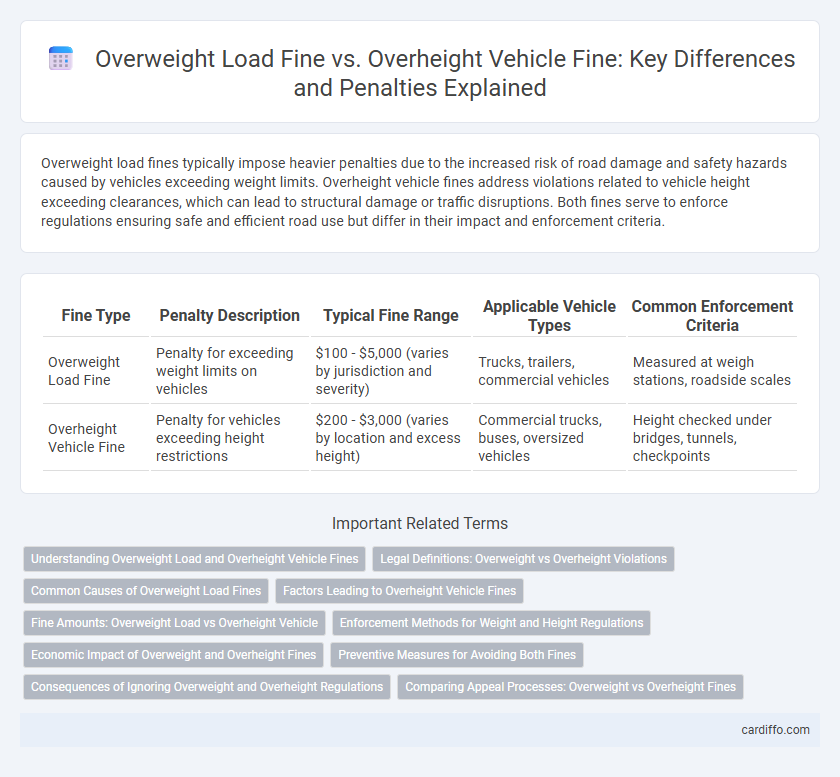Overweight load fines typically impose heavier penalties due to the increased risk of road damage and safety hazards caused by vehicles exceeding weight limits. Overheight vehicle fines address violations related to vehicle height exceeding clearances, which can lead to structural damage or traffic disruptions. Both fines serve to enforce regulations ensuring safe and efficient road use but differ in their impact and enforcement criteria.
Table of Comparison
| Fine Type | Penalty Description | Typical Fine Range | Applicable Vehicle Types | Common Enforcement Criteria |
|---|---|---|---|---|
| Overweight Load Fine | Penalty for exceeding weight limits on vehicles | $100 - $5,000 (varies by jurisdiction and severity) | Trucks, trailers, commercial vehicles | Measured at weigh stations, roadside scales |
| Overheight Vehicle Fine | Penalty for vehicles exceeding height restrictions | $200 - $3,000 (varies by location and excess height) | Commercial trucks, buses, oversized vehicles | Height checked under bridges, tunnels, checkpoints |
Understanding Overweight Load and Overheight Vehicle Fines
Overweight load fines are imposed when vehicles exceed the legally permitted weight limits, risking road damage and safety hazards. Overheight vehicle fines apply to vehicles that surpass height restrictions, potentially causing structural damage to bridges and tunnels. Understanding these fines helps ensure compliance with transportation regulations and promotes road safety.
Legal Definitions: Overweight vs Overheight Violations
Overweight load violations occur when a vehicle exceeds the maximum allowable weight limits set by transportation authorities, risking road damage and safety hazards. Overheight vehicle fines result from a vehicle surpassing the legal height restrictions designed to prevent collisions with overhead structures like bridges and tunnels. Legal definitions distinguish these infractions based on specific measurements: weight is measured in tons or kilograms, while height is regulated in meters or feet, with each violation carrying distinct penalties and operational restrictions under state and federal laws.
Common Causes of Overweight Load Fines
Overweight load fines commonly result from exceeding legal weight limits due to improper cargo distribution, inaccurate load calculations, or failure to account for additional equipment weight. Overheight vehicle fines typically occur because of insufficient route planning, ignoring height restrictions, or neglecting to measure vehicle height accurately. Understanding these causes helps operators avoid penalties by ensuring compliance with weight and height regulations.
Factors Leading to Overheight Vehicle Fines
Overheight vehicle fines commonly result from factors such as inadequate route planning, failure to comply with height restrictions posted on bridges and tunnels, and improper vehicle modifications exceeding legal height limits. Drivers often overlook critical clearance signs, leading to collisions or traffic disruptions that prompt strict enforcement and penalties. These fines serve as deterrents to ensure vehicle dimensions comply with infrastructure safety standards, contrasting with overweight load fines that primarily address weight-related road damage concerns.
Fine Amounts: Overweight Load vs Overheight Vehicle
Fine amounts for overweight load violations often exceed those for overheight vehicles due to the increased risk of road damage and accidents, with penalties ranging from $500 to $5,000 depending on the severity and jurisdiction. Overheight vehicle fines typically range between $200 and $1,500 but can escalate if the vehicle causes infrastructure damage such as bridge strikes. Enforcement agencies set fine structures based on the potential hazards and repair costs, reflecting stricter financial repercussions for overweight load violations.
Enforcement Methods for Weight and Height Regulations
Enforcement methods for overweight load and overheight vehicle fines include weigh stations equipped with advanced scale systems and automated height detection sensors strategically placed along highways. Law enforcement agencies utilize portable enforcement tools such as weigh-in-motion technology and laser-based height measurement to accurately assess compliance without disrupting traffic flow. These combined methods ensure precise monitoring, effective deterrence, and timely issuance of fines for violations of weight and height regulations.
Economic Impact of Overweight and Overheight Fines
Overweight vehicle fines significantly impact economic activities by increasing transportation costs, leading to delays in goods delivery and higher logistics expenses. Overheight vehicle fines contribute to structural damage risks, causing costly repairs and disrupting traffic flow, which in turn affect supply chain efficiency and operational budgets. Both fines serve as deterrents to vehicle violations but impose substantial economic burdens on freight companies and infrastructure maintenance budgets.
Preventive Measures for Avoiding Both Fines
Implementing regular vehicle inspections and adhering to weight limits through accurate load distribution are key preventive measures for avoiding overweight load fines. Installing height detection systems and planning routes that accommodate the vehicle's dimensions help prevent overheight vehicle fines effectively. Driver training on compliance with legal regulations further reduces the risk of incurring both overweight and overheight penalties.
Consequences of Ignoring Overweight and Overheight Regulations
Ignoring overweight load regulations can result in severe penalties including hefty fines, vehicle impoundment, and increased risk of road damage leading to costly repairs and potential legal liability. Overheight vehicle violations often cause structural damage to bridges and tunnels, resulting in fines, repair costs, and extended traffic disruptions. Both breaches heighten safety risks, contributing to accidents and endangering public welfare, with insurance claims possibly becoming nullified due to non-compliance.
Comparing Appeal Processes: Overweight vs Overheight Fines
Appealing overweight load fines typically involves submitting detailed weight certificates and evidence of load distribution to transportation authorities, whereas overheight vehicle fine appeals focus on providing proof of vehicle modifications or height measurements. The appeal process for overweight fines often requires technical documentation from certified weigh stations, contrasting with overheight appeals that may demand engineering assessments or clearance permits. Both appeals necessitate timely submissions and adherence to regulatory guidelines, but overweight fine appeals generally involve more complex verification due to safety and infrastructure impact concerns.
Overweight load fine vs Overheight vehicle fine Infographic

 cardiffo.com
cardiffo.com